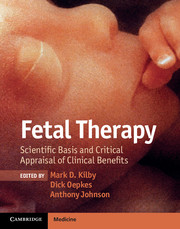Book contents
- Frontmatter
- Contents
- Contributors
- Foreword
- Preface
- Section 1 General principles
- Section 2 Fetal disease
- Chapter 6 Red cell alloimmunization
- Chapter 7 Fetal and neonatal alloimmune thrombocytopenia
- Chapter 8.1 Fetal dysrhythmias
- Chapter 8.2 Fetal dysrhythmias
- Chapter 9.1 Structural heart disease
- Chapter 9.2 Structural heart disease
- Chapter 9.3 Structural heart disease
- Chapter 10.1 Manipulation of amniotic fluid volume
- Chapter 10.2 Manipulation of amniotic fluid volume
- Chapter 11.1 Twin-to-twin transfusion syndrome
- Chapter 11.2 Twin-to-twin transfusion syndrome
- Chapter 11.3 Twin-to-twin transfusion syndrome
- Chapter 11.4 Twin-to-twin transfusion syndrome
- Chapter 11.5 Twin-to-twin transfusion syndrome
- Chapter 12.1 Twin reversed arterial perfusion (TRAP) sequence
- Chapter 12.2 Twin reversed arterial perfusion (TRAP) sequence
- Chapter 13.1 Fetal infections
- Chapter 13.2 Fetal infections
- Chapter 14.1 Fetal urinary tract obstruction
- Chapter 14.2 Fetal urinary tract obstruction
- Chapter 14.3 Fetal urinary tract obstruction
- Chapter 14.4 Fetal urinary tract obstruction
- 15.1 Fetal lung growth, development, and lung fluid
- Chapter 15.2 Fetal lung growth, development, and lung fluid
- Chapter 16.1 Neural tube defects
- Chapter 16.2 Neural tube defects
- Chapter 17.1 Fetal tumors
- Chapter 17.2 Fetal tumors
- Chapter 18.1 Intrauterine growth restriction
- Chapter 18.2 Intrauterine growth restriction
- Chapter 19.1 Congenital diaphragmatic hernia
- Chapter 19.2 Congenital diaphragmatic hernia
- Chapter 20.1 Fetal stem cell transplantation
- Chapter 20.2 Fetal stem cell transplantation
- Chapter 20.3 Fetal stem cell transplantation
- Chapter 21 Gene therapy
- Chapter 22 The future
- Glossary
- Index
- References
Chapter 10.1 - Manipulation of amniotic fluid volume
Homeostasis of fluid volumes in the amniotic cavity
from Section 2 - Fetal disease
Published online by Cambridge University Press: 05 February 2013
- Frontmatter
- Contents
- Contributors
- Foreword
- Preface
- Section 1 General principles
- Section 2 Fetal disease
- Chapter 6 Red cell alloimmunization
- Chapter 7 Fetal and neonatal alloimmune thrombocytopenia
- Chapter 8.1 Fetal dysrhythmias
- Chapter 8.2 Fetal dysrhythmias
- Chapter 9.1 Structural heart disease
- Chapter 9.2 Structural heart disease
- Chapter 9.3 Structural heart disease
- Chapter 10.1 Manipulation of amniotic fluid volume
- Chapter 10.2 Manipulation of amniotic fluid volume
- Chapter 11.1 Twin-to-twin transfusion syndrome
- Chapter 11.2 Twin-to-twin transfusion syndrome
- Chapter 11.3 Twin-to-twin transfusion syndrome
- Chapter 11.4 Twin-to-twin transfusion syndrome
- Chapter 11.5 Twin-to-twin transfusion syndrome
- Chapter 12.1 Twin reversed arterial perfusion (TRAP) sequence
- Chapter 12.2 Twin reversed arterial perfusion (TRAP) sequence
- Chapter 13.1 Fetal infections
- Chapter 13.2 Fetal infections
- Chapter 14.1 Fetal urinary tract obstruction
- Chapter 14.2 Fetal urinary tract obstruction
- Chapter 14.3 Fetal urinary tract obstruction
- Chapter 14.4 Fetal urinary tract obstruction
- 15.1 Fetal lung growth, development, and lung fluid
- Chapter 15.2 Fetal lung growth, development, and lung fluid
- Chapter 16.1 Neural tube defects
- Chapter 16.2 Neural tube defects
- Chapter 17.1 Fetal tumors
- Chapter 17.2 Fetal tumors
- Chapter 18.1 Intrauterine growth restriction
- Chapter 18.2 Intrauterine growth restriction
- Chapter 19.1 Congenital diaphragmatic hernia
- Chapter 19.2 Congenital diaphragmatic hernia
- Chapter 20.1 Fetal stem cell transplantation
- Chapter 20.2 Fetal stem cell transplantation
- Chapter 20.3 Fetal stem cell transplantation
- Chapter 21 Gene therapy
- Chapter 22 The future
- Glossary
- Index
- References
Summary
Introduction
Human pregnancies contain large amounts of water in several compartments, including the fetal body, the placenta and membranes, and the amniotic fluid (AF). This water circulates within the conceptus and also between fetus and mother. Normal acquisition and circulation of water is critical to fetal health and development and abnormal amounts of water, evidenced as insufficient (oligohydramnios) or excessive (polyhydramnios) amounts of AF, are associated with impaired fetal outcome, even in the absence of structural fetal abnormalities. This chapter will review the current understanding of water flow into the gestation and into and out of the amniotic cavity, and will review evidence suggesting that the fetus may regulate the AF volume.
Fetal water compartments
The fetal body is composed largely of water. A preterm fetus may be almost 90% water, although near term the proportion is closer to 70% [1, 2]. A 3500 g term human fetus would therefore contain about 2500 ml of water, 350 ml of which are in the vascular compartment, 1000 ml in the intracellular space, and the remainder extracellular [3]. Similarly, the placenta is approximately 85% water [4]; the term fetus would therefore devote about 500 ml of water to the placenta. Lastly, the fetus has a variable, but relatively large, amount of water stored in the amniotic cavity – the AF. Although AF volume is much less related to fetal size, a normal term fetus would have 500–1200 ml [5] in the AF (Figure 10.1.1).
Keywords
- Type
- Chapter
- Information
- Fetal TherapyScientific Basis and Critical Appraisal of Clinical Benefits, pp. 128 - 136Publisher: Cambridge University PressPrint publication year: 2012
References
- 1
- Cited by

